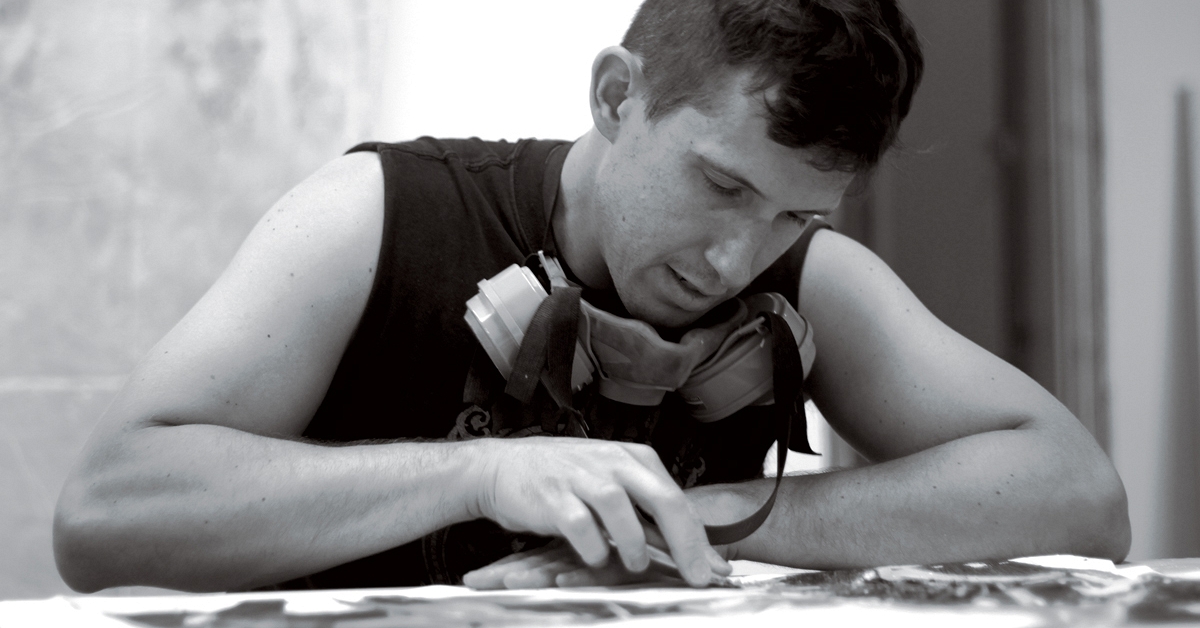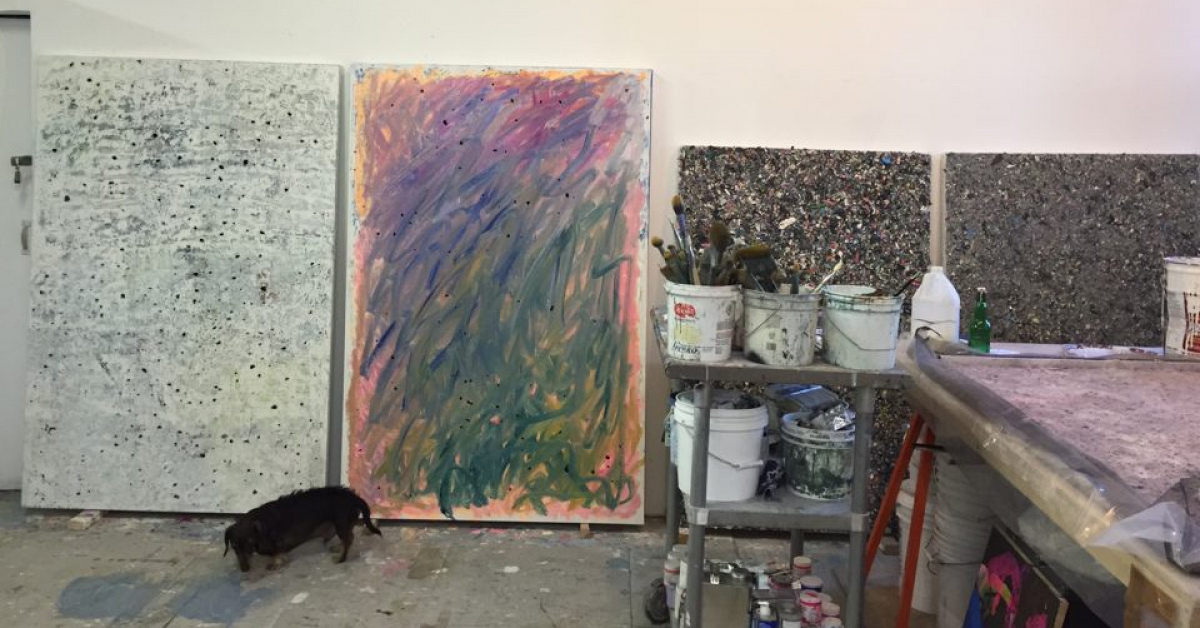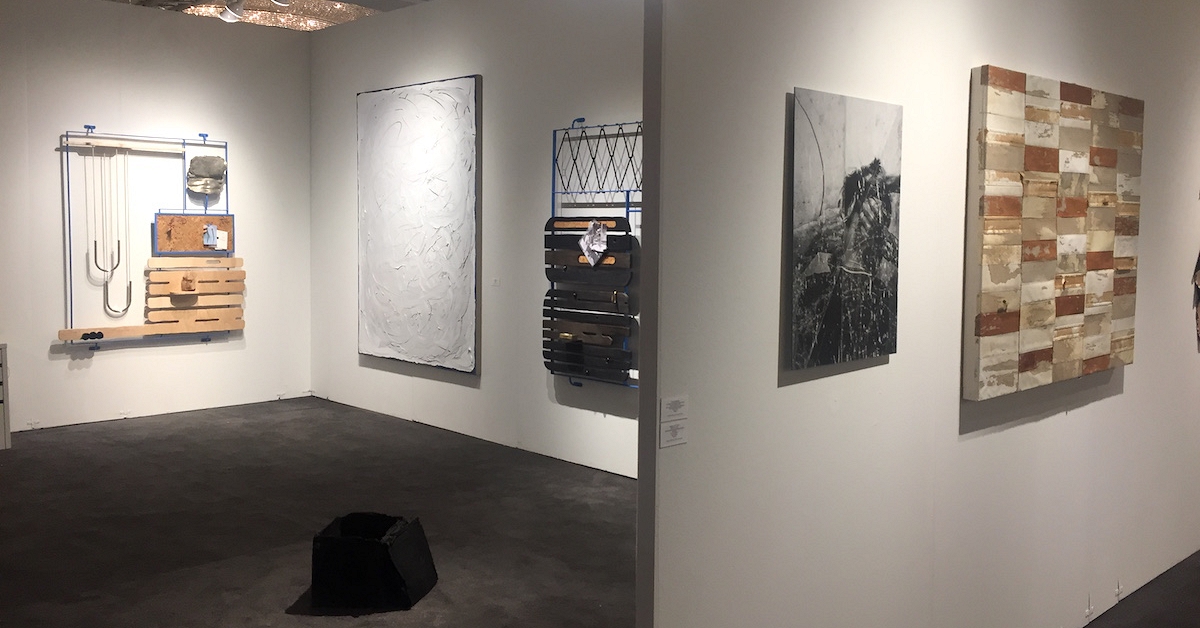Black Grief, White Grievance: Artists Search for Racial Justice
New York Times / Feb 18, 2021 / by Holland Carter / Go to Original
An urgent show at the New Museum — both a monument to a resilient culture and a memorial to what’s lost through racism — will surely rank as one of the most important of 2021.
In the matter of racial justice, the United States has built up terrible karma over the centuries. And in the past four divisive years, the festering badness, in the form of white nationalism, has been there for all the world to see. The Nigerian-born curator Okwui Enwezor saw it, and the impassioned exhibition “Grief and Grievance: Art and Mourning in America” at the New Museum was his direct and personal response, one that he conceived as a moral broadside and intended to deliver just ahead of the 2020 presidential election.
Fate intervened. Enwezor succumbed to cancer in 2019, at 55, a loss lamented throughout the international art world which he had done much, through his reverberant exhibitions and books, to shape. At that point, four of his longtime colleagues — Massimiliano Gioni, the artistic director of the New Museum; the artist Glenn Ligon; Mark Nash, an art history professor at the University of California, Santa Cruz; and Naomi Beckwith, a senior curator at the Museum of Contemporary Art, Chicago, and soon to be deputy director and chief curator at the Guggenheim Museum — banded together to realize his show. Working from his notes and conversations with him, they gathered the art he had specified, made some additions of their own, and published a catalog.
When I looked through the book in advance of the opening, I had reservations about the project. Most of the 37 Black artists included are familiar and widely exhibited, as are some of the individual works. I wondered if the show, even with the gravity of its theme, wouldn’t end up feeling, basically, like not much more than a reaffirmation of a contemporary art canon, a cavalcade of stars.
But curating, at its best, is far less about singularity than it is about synthesis, about the alchemy of bringing things together to ignite and amplify ideas. Enwezor had a genius eye for such creative fusion, and it has produced exceptionally moving results in an exhibition that will surely rank as one of the most important of 2021. It is a fitting tribute to its maker, an honor to a team that saw it through, and a worthy frame for the artists who contributed to it, among them some of the greatest we have.
The title lays out the show’s intertwined themes: Black grief in response to white racist aggression, and white grievance fueled by a feared loss of dominance and control. A sense of their volatile chemistry is distilled on the New Museum’s facade in a Glenn Ligon text piece that spells out, in large white neon letters, the phrase “blues blood bruise,” words extracted from an interview with a Black New York City teenager, Daniel Hamm, who in 1964 was arrested and brutally beaten by the police.
The theme of racial tension is picked up immediately inside the museum. For a conceptual work titled “Presumption of guilt,” the artist Cameron Rowland has rigged the entrance door with an alert bell, of a kind used in commercial shops to warn owners of the presence of potentially larcenous customers.
And another artist, Adam Pendleton, has covered the lobby walls with silk-screen images that include graffiti-style signage, a form of public writing often associated, in the white-dominated news media, with urban lawlessness and, by implication, a Black presence. Pendleton pointedly plays on these expectations by incorporating examples of graffiti protesting the 2020 police killing of George Floyd in Minneapolis.
Enwezor was allergic to narrow-gauge readings of categories like “political art” and “protest art” (and, for that matter, “Black art”). He favored subtlety, ambiguity, purposeful indirection, all evident in different ways, and to different degrees, in the work of three artists in the lobby gallery who introduce themes that will reverberate through the main exhibition spaces on the museum’s second, third and fourth floors.
A short narrative film, “Alone,” by Garrett Bradley dramatizes the engulfing emotional cost of Black mass incarceration by viewing it through the eyes of a young woman whose lover is in jail. A ready-made sculpture by the remarkable Tiona Nekkia McClodden, consisting of a steel contraption commercially used to hold cattle about to be slaughtered speaks, in the context of this exhibition, to the murderous realities of slavery. And a set of large photographs by Terry Adkins (1953-2014) of “memory jugs,” traditional relic-filled African-American funerary objects, underscores the show’s function as both a monument to a rich, resilient culture, and a memorial to what’s lost through racism — rights of citizenship, lives to Covid-19 — every day.
One of the show’s earliest pieces, installed on the second floor, is, in effect, a civil rights era reliquary. Titled “Freedom Now, Number I, August 13, 1963-January 14, 1964,” it’s an assemblage by Daniel LaRue Johnson (1938-2017) made in the months after the 1963 March on Washington when he was traveling through the American South. As he went, he picked up odds and ends (a broken doll, a mousetrap, a hacksaw blade, and a “Freedom Now” protest button), attached them to a canvas and smothered them in layers of black pitch, an everyday material that carried some terrible associations, of bodies tar-and-feathered and torched.
For Enwezor, this piece was one of the exhibition’s touchstone works, maybe because it adds a charge of you-were-there realness to other, newer works referring to the civil rights era. These include Dawoud Bey’s 2012 portrait series called “The Birmingham Project,” a memorial to the four young girls killed in the 1963 bombing, by Ku Klux Klan terrorists, of the city’s 16th Street Baptist Church; and Carrie Mae Weems’s hushed, funereal photographic re-imaginings of key 1960s events. Her picture titled “The Assassination of Medgar, Malcolm and Martin” seems to be set in a morgue.
And if there’s a single indelible emblem of “mourning” in the show, it’s Nari Ward’s installation, “Peace Keeper,” originally made for the 1995 Whitney Biennial, subsequently destroyed, and recreated, at Enwezor’s request, for his show. Comprising a full-size, beat-up black hearse enclosed in a steel cage beneath a kind of thundercloud of rusted exhaust pipes and mufflers, it’s materially overpowering, even off-putting, a little scary. It’s only when you stand close that you see delicacy: The car’s surface is flecked with iridescent peacock feathers.
Is “Peace Keeper” a “political” work? Hard to say. On the one hand, it seems to set Blackness in an environment of entrapment, stalled motion and ruin. But then there are the stabbing traces of beauty: the feathers. The humiliation of tar-and-feathering is evoked here too, but so is a message of flight. And there’s the title. This particular “peace keeper” looks to be a prisoner of war. All in all, the piece defies any easy reading. Materially, it’s almost too much, but conceptually, it’s elusive and in that sense almost abstract, as is true of much of the political art Enwezor valued.
There are strong examples of such art on the museum’s third floor. Howardena Pindell’s “Autobiography: Water (Ancestors/Middle Passage/Family Ghosts)” is one: a collage painting with the figure of the artist herself floating, in spectral outline, on an ocean littered with what looks like mortal wreckage — body parts, staring eyes. Another is Melvin Edwards’s great series of wall sculptures, “Lynch Fragments” — there are 10 examples in the show, each a fierce knot of welded-together spikes, chains and screws. And Charles Gaines’s multimedia “Manifestos 3” is a third. In it, the exhortative words of James Baldwin and Martin Luther King, Jr. have been converted into a musical score, recordings of which sound through the gallery.
Indeed, this show is as much an aural as a visual experience. Sound, in one form or another, is everywhere. Some of it is actually silent, as in the case of Jennie C. Jones’s exquisite line drawings collectively titled “Score for Sustained Blackness, Set 3.” Some is happenstantial: microphones embedded in Kevin Beasley’s suspended sculpture “Strange Fruit (Pair 1)” pick up and amplify ambient gallery noise.
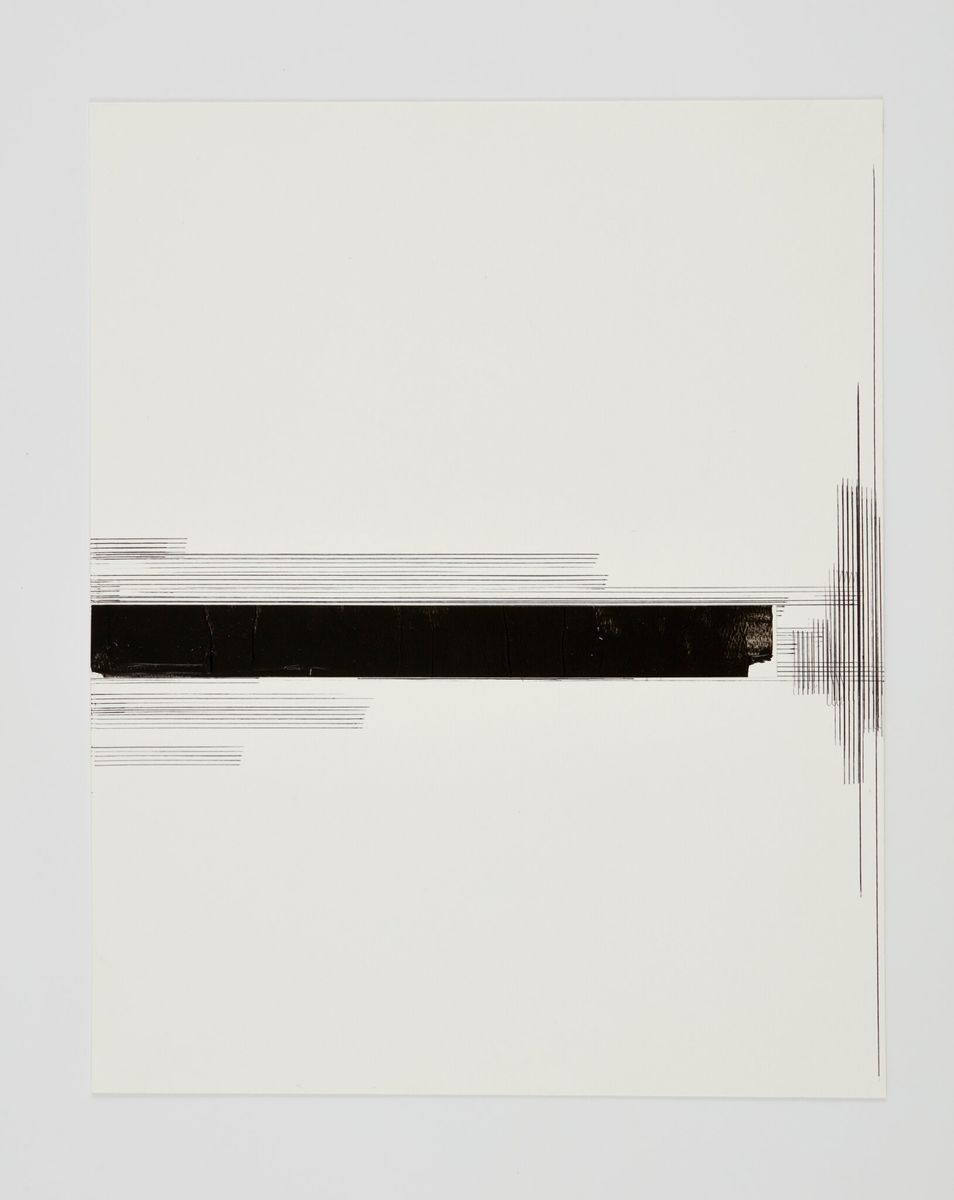
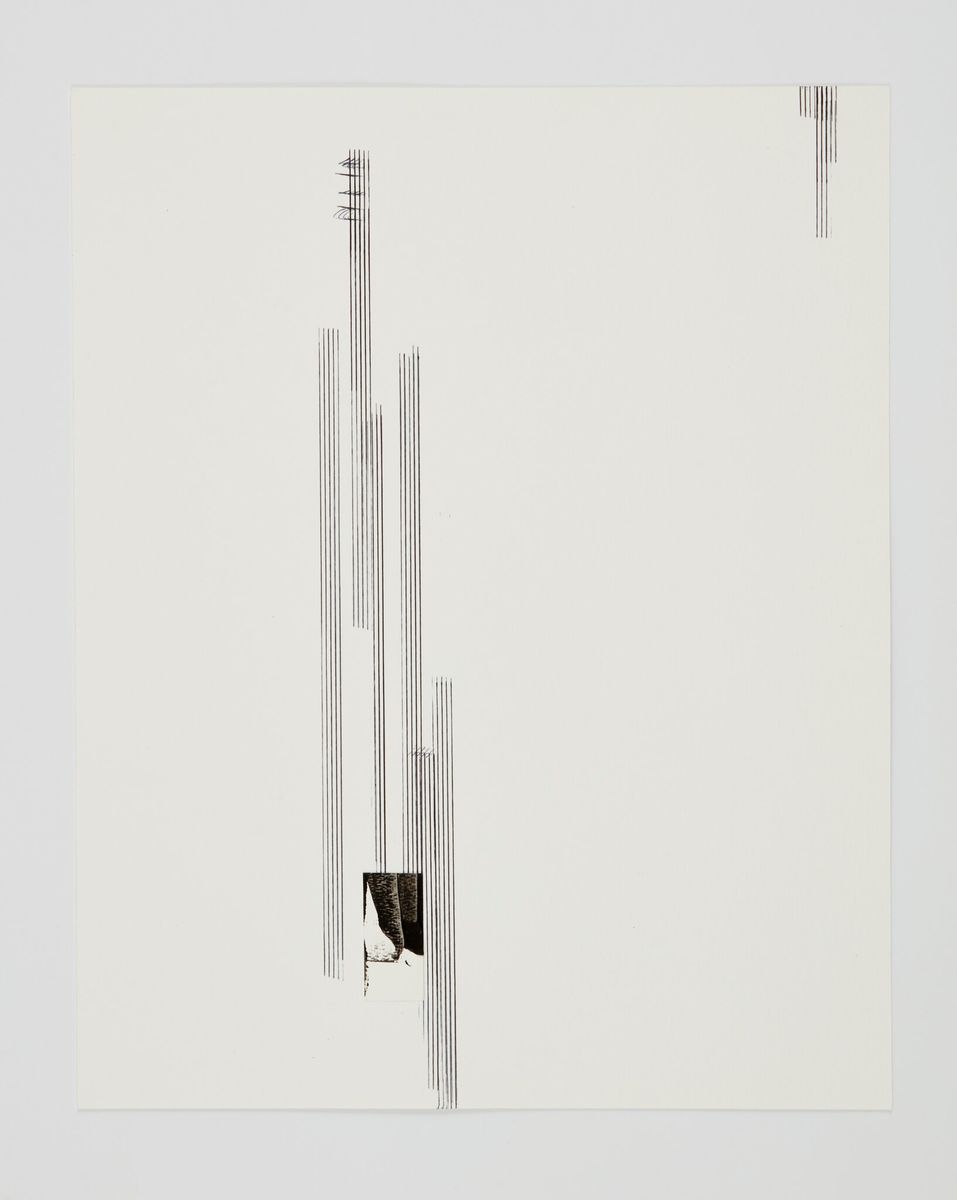 Jennie C. Jones’s line drawings, collectively titled “Score for Sustained Blackness Set 3,” from 2016.
Jennie C. Jones’s line drawings, collectively titled “Score for Sustained Blackness Set 3,” from 2016.
Credit: Jennie C. Jones; PATRON Gallery and Alexander Gray Associates
And there’s music, lots of it, on every floor. In the keening laments of the jazz singer Alice Smith, as recorded on video by Kahlil Joseph. In Theaster Gates’s thunderous percussion jam with the Black Monks in a half-wrecked church. And in sometimes recorded, sometimes live piano improvisations emanating from a cabana-like installation by Rashid Johnson that’s part salon, part greenhouse and part Black history library.
The Johnson piece is on the fourth floor, along with abstract paintings by Mark Bradford and Julie Mehretu. Together, they form an ensemble bright and busy enough to suggest that maybe, by this point in the show, mourning is over, we’ve gotten beyond it, left it behind in the galleries below. Yet such an impression would not be entirely accurate.
The mural-size Bradford picture, it turns out, traces the contours of a government surveillance map of Black neighborhoods in Los Angeles. Issued in the wake of the 1965 Watts rebellion, it was an example of cartography used as a tool for civic control. The four Mehretu paintings on view also carry political content. Half-hidden under abstract patterns in one is a drawing of an image of the 2017 white supremacist rally in Charlottesville, Va.
But it’s another, less conspicuous fourth floor piece that most powerfully encapsulates the karmic interlock — a plague of white aggrievement meeting an emergency of Black grief — that gives the show its theme.
The work is an assemblage painting by Jack Whitten (1939-2018) titled “Birmingham” and dated to 1964. Whitten was born in Alabama, was active in the civil rights movement there, and in 1959, fled the South, never to return. Which doesn’t mean he didn’t look back. In this small piece, done in the aftermath of the 1963 Birmingham church bombing, he did.
The main image is a clipped news photograph of an African-American man at a protest being attacked — it looks like he’s being torn apart — by a white policeman with a dog. (It was after being beaten at such a protest that Whitten took a one-way bus North.) In the piece, the photo is encased, as if it were precious or radioactive, in a nest of molded aluminum foil. And the nest appears to have been half blown open, as if ripped by a detonation that been paused mid-blast.
Can the destruction in progress be stopped, or must it go forward? That’s the question that Enwezor, in his final, urgent show, insists we ask.
In the matter of racial justice, the United States has built up terrible karma over the centuries. And in the past four divisive years, the festering badness, in the form of white nationalism, has been there for all the world to see. The Nigerian-born curator Okwui Enwezor saw it, and the impassioned exhibition “Grief and Grievance: Art and Mourning in America” at the New Museum was his direct and personal response, one that he conceived as a moral broadside and intended to deliver just ahead of the 2020 presidential election.
Fate intervened. Enwezor succumbed to cancer in 2019, at 55, a loss lamented throughout the international art world which he had done much, through his reverberant exhibitions and books, to shape. At that point, four of his longtime colleagues — Massimiliano Gioni, the artistic director of the New Museum; the artist Glenn Ligon; Mark Nash, an art history professor at the University of California, Santa Cruz; and Naomi Beckwith, a senior curator at the Museum of Contemporary Art, Chicago, and soon to be deputy director and chief curator at the Guggenheim Museum — banded together to realize his show. Working from his notes and conversations with him, they gathered the art he had specified, made some additions of their own, and published a catalog.
When I looked through the book in advance of the opening, I had reservations about the project. Most of the 37 Black artists included are familiar and widely exhibited, as are some of the individual works. I wondered if the show, even with the gravity of its theme, wouldn’t end up feeling, basically, like not much more than a reaffirmation of a contemporary art canon, a cavalcade of stars.
But curating, at its best, is far less about singularity than it is about synthesis, about the alchemy of bringing things together to ignite and amplify ideas. Enwezor had a genius eye for such creative fusion, and it has produced exceptionally moving results in an exhibition that will surely rank as one of the most important of 2021. It is a fitting tribute to its maker, an honor to a team that saw it through, and a worthy frame for the artists who contributed to it, among them some of the greatest we have.
The title lays out the show’s intertwined themes: Black grief in response to white racist aggression, and white grievance fueled by a feared loss of dominance and control. A sense of their volatile chemistry is distilled on the New Museum’s facade in a Glenn Ligon text piece that spells out, in large white neon letters, the phrase “blues blood bruise,” words extracted from an interview with a Black New York City teenager, Daniel Hamm, who in 1964 was arrested and brutally beaten by the police.
The theme of racial tension is picked up immediately inside the museum. For a conceptual work titled “Presumption of guilt,” the artist Cameron Rowland has rigged the entrance door with an alert bell, of a kind used in commercial shops to warn owners of the presence of potentially larcenous customers.
And another artist, Adam Pendleton, has covered the lobby walls with silk-screen images that include graffiti-style signage, a form of public writing often associated, in the white-dominated news media, with urban lawlessness and, by implication, a Black presence. Pendleton pointedly plays on these expectations by incorporating examples of graffiti protesting the 2020 police killing of George Floyd in Minneapolis.
Enwezor was allergic to narrow-gauge readings of categories like “political art” and “protest art” (and, for that matter, “Black art”). He favored subtlety, ambiguity, purposeful indirection, all evident in different ways, and to different degrees, in the work of three artists in the lobby gallery who introduce themes that will reverberate through the main exhibition spaces on the museum’s second, third and fourth floors.
A short narrative film, “Alone,” by Garrett Bradley dramatizes the engulfing emotional cost of Black mass incarceration by viewing it through the eyes of a young woman whose lover is in jail. A ready-made sculpture by the remarkable Tiona Nekkia McClodden, consisting of a steel contraption commercially used to hold cattle about to be slaughtered speaks, in the context of this exhibition, to the murderous realities of slavery. And a set of large photographs by Terry Adkins (1953-2014) of “memory jugs,” traditional relic-filled African-American funerary objects, underscores the show’s function as both a monument to a rich, resilient culture, and a memorial to what’s lost through racism — rights of citizenship, lives to Covid-19 — every day.
One of the show’s earliest pieces, installed on the second floor, is, in effect, a civil rights era reliquary. Titled “Freedom Now, Number I, August 13, 1963-January 14, 1964,” it’s an assemblage by Daniel LaRue Johnson (1938-2017) made in the months after the 1963 March on Washington when he was traveling through the American South. As he went, he picked up odds and ends (a broken doll, a mousetrap, a hacksaw blade, and a “Freedom Now” protest button), attached them to a canvas and smothered them in layers of black pitch, an everyday material that carried some terrible associations, of bodies tar-and-feathered and torched.
For Enwezor, this piece was one of the exhibition’s touchstone works, maybe because it adds a charge of you-were-there realness to other, newer works referring to the civil rights era. These include Dawoud Bey’s 2012 portrait series called “The Birmingham Project,” a memorial to the four young girls killed in the 1963 bombing, by Ku Klux Klan terrorists, of the city’s 16th Street Baptist Church; and Carrie Mae Weems’s hushed, funereal photographic re-imaginings of key 1960s events. Her picture titled “The Assassination of Medgar, Malcolm and Martin” seems to be set in a morgue.
And if there’s a single indelible emblem of “mourning” in the show, it’s Nari Ward’s installation, “Peace Keeper,” originally made for the 1995 Whitney Biennial, subsequently destroyed, and recreated, at Enwezor’s request, for his show. Comprising a full-size, beat-up black hearse enclosed in a steel cage beneath a kind of thundercloud of rusted exhaust pipes and mufflers, it’s materially overpowering, even off-putting, a little scary. It’s only when you stand close that you see delicacy: The car’s surface is flecked with iridescent peacock feathers.
Is “Peace Keeper” a “political” work? Hard to say. On the one hand, it seems to set Blackness in an environment of entrapment, stalled motion and ruin. But then there are the stabbing traces of beauty: the feathers. The humiliation of tar-and-feathering is evoked here too, but so is a message of flight. And there’s the title. This particular “peace keeper” looks to be a prisoner of war. All in all, the piece defies any easy reading. Materially, it’s almost too much, but conceptually, it’s elusive and in that sense almost abstract, as is true of much of the political art Enwezor valued.
There are strong examples of such art on the museum’s third floor. Howardena Pindell’s “Autobiography: Water (Ancestors/Middle Passage/Family Ghosts)” is one: a collage painting with the figure of the artist herself floating, in spectral outline, on an ocean littered with what looks like mortal wreckage — body parts, staring eyes. Another is Melvin Edwards’s great series of wall sculptures, “Lynch Fragments” — there are 10 examples in the show, each a fierce knot of welded-together spikes, chains and screws. And Charles Gaines’s multimedia “Manifestos 3” is a third. In it, the exhortative words of James Baldwin and Martin Luther King, Jr. have been converted into a musical score, recordings of which sound through the gallery.
Indeed, this show is as much an aural as a visual experience. Sound, in one form or another, is everywhere. Some of it is actually silent, as in the case of Jennie C. Jones’s exquisite line drawings collectively titled “Score for Sustained Blackness, Set 3.” Some is happenstantial: microphones embedded in Kevin Beasley’s suspended sculpture “Strange Fruit (Pair 1)” pick up and amplify ambient gallery noise.


Credit: Jennie C. Jones; PATRON Gallery and Alexander Gray Associates
And there’s music, lots of it, on every floor. In the keening laments of the jazz singer Alice Smith, as recorded on video by Kahlil Joseph. In Theaster Gates’s thunderous percussion jam with the Black Monks in a half-wrecked church. And in sometimes recorded, sometimes live piano improvisations emanating from a cabana-like installation by Rashid Johnson that’s part salon, part greenhouse and part Black history library.
The Johnson piece is on the fourth floor, along with abstract paintings by Mark Bradford and Julie Mehretu. Together, they form an ensemble bright and busy enough to suggest that maybe, by this point in the show, mourning is over, we’ve gotten beyond it, left it behind in the galleries below. Yet such an impression would not be entirely accurate.
The mural-size Bradford picture, it turns out, traces the contours of a government surveillance map of Black neighborhoods in Los Angeles. Issued in the wake of the 1965 Watts rebellion, it was an example of cartography used as a tool for civic control. The four Mehretu paintings on view also carry political content. Half-hidden under abstract patterns in one is a drawing of an image of the 2017 white supremacist rally in Charlottesville, Va.
But it’s another, less conspicuous fourth floor piece that most powerfully encapsulates the karmic interlock — a plague of white aggrievement meeting an emergency of Black grief — that gives the show its theme.
The work is an assemblage painting by Jack Whitten (1939-2018) titled “Birmingham” and dated to 1964. Whitten was born in Alabama, was active in the civil rights movement there, and in 1959, fled the South, never to return. Which doesn’t mean he didn’t look back. In this small piece, done in the aftermath of the 1963 Birmingham church bombing, he did.
The main image is a clipped news photograph of an African-American man at a protest being attacked — it looks like he’s being torn apart — by a white policeman with a dog. (It was after being beaten at such a protest that Whitten took a one-way bus North.) In the piece, the photo is encased, as if it were precious or radioactive, in a nest of molded aluminum foil. And the nest appears to have been half blown open, as if ripped by a detonation that been paused mid-blast.
Can the destruction in progress be stopped, or must it go forward? That’s the question that Enwezor, in his final, urgent show, insists we ask.

